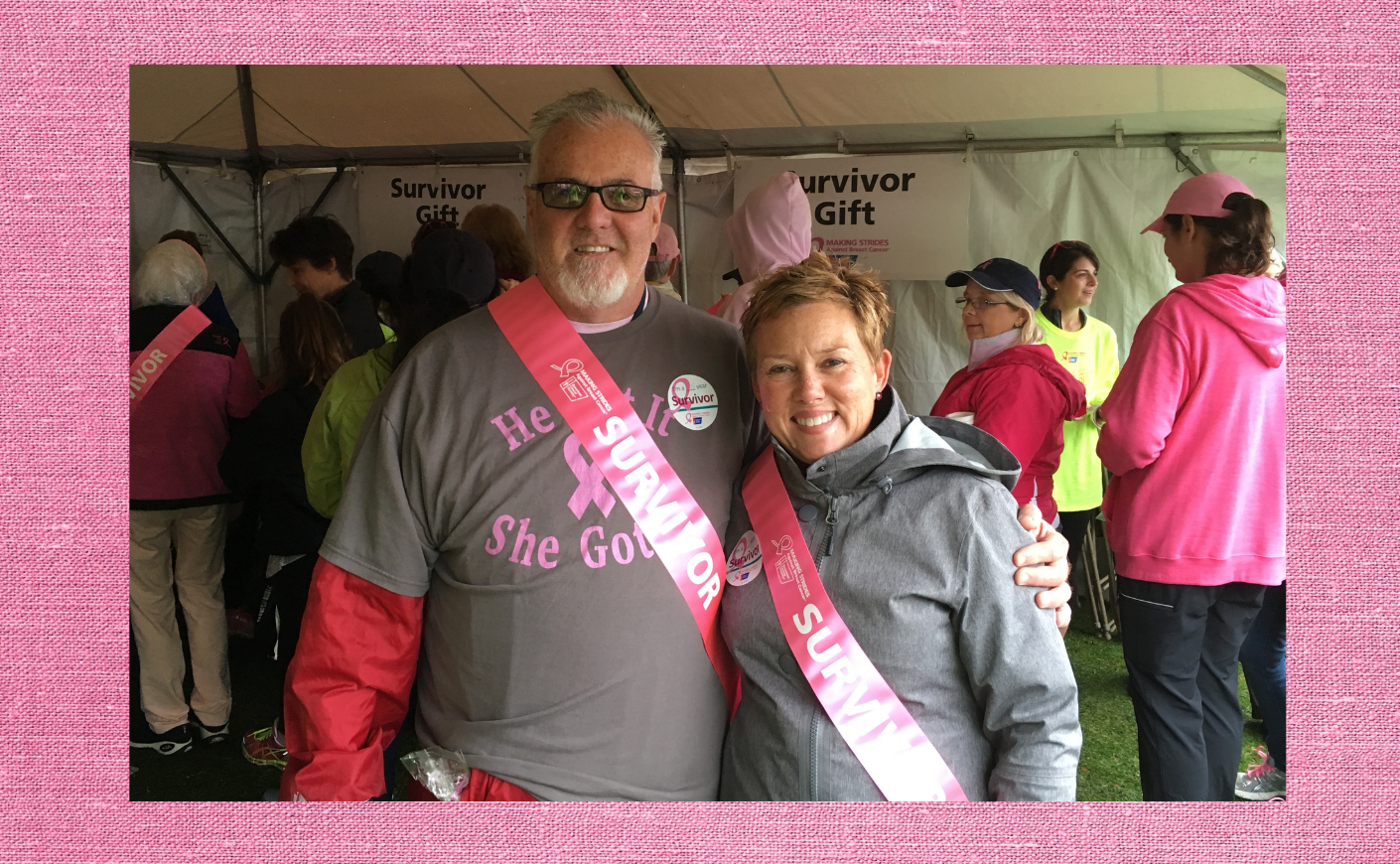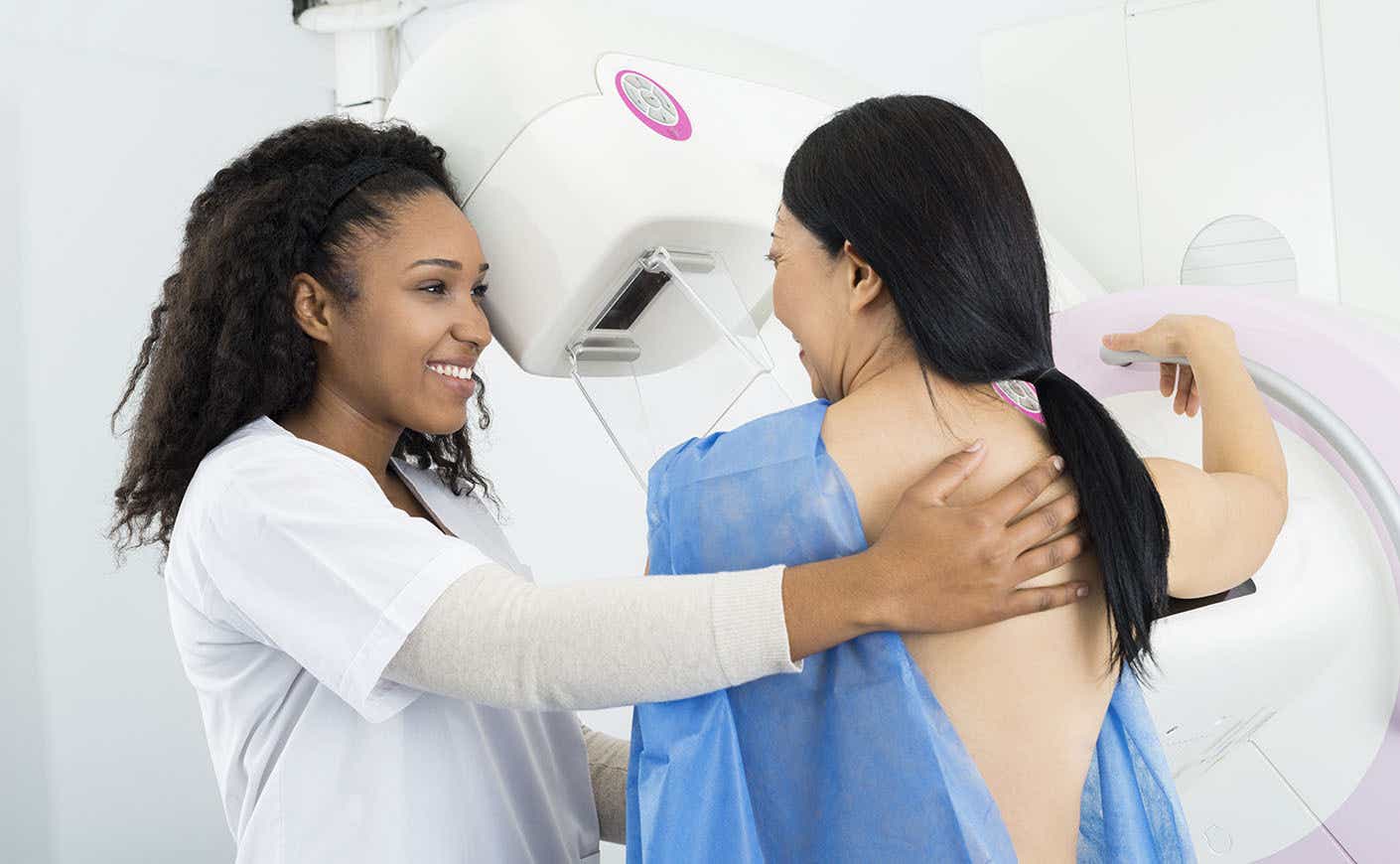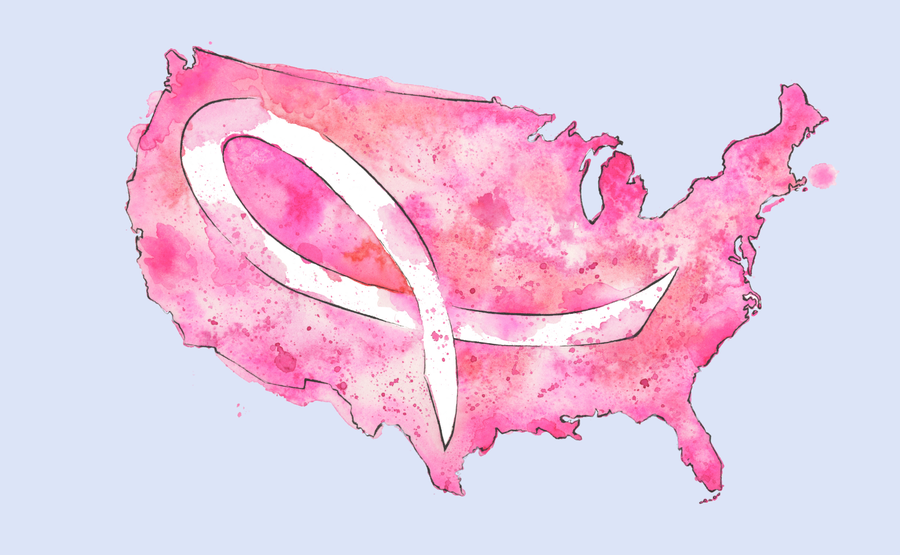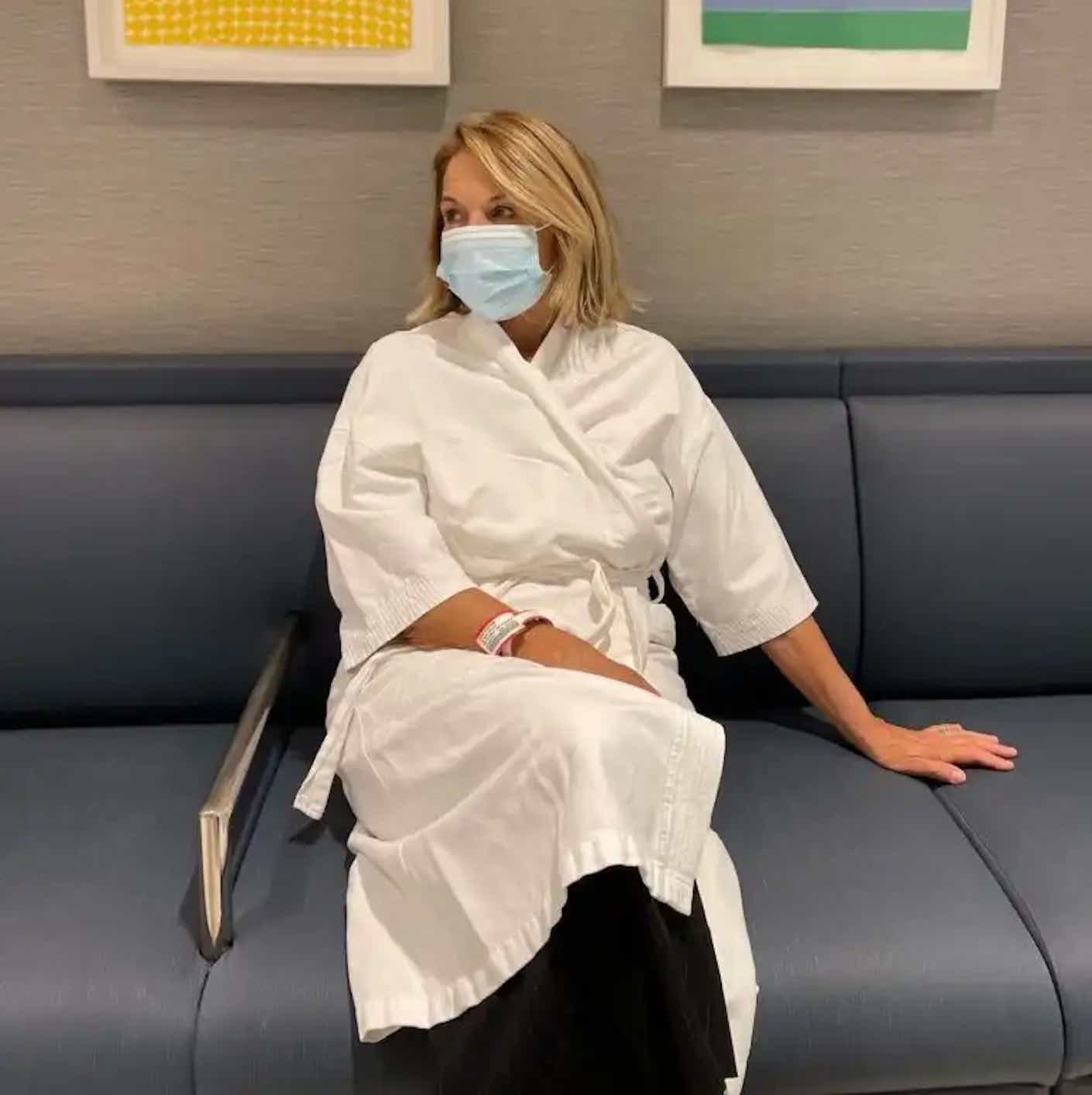Our comprehensive breast cancer coverage ranges from practical advice to heart-wrenching personal stories.
Since 1985, we’ve observed Breast Cancer Awareness Month every October. The month is a time to inform ourselves about breast cancer diagnosis and treatment, but we also celebrate survivor stories and grieve loved ones. It’s a tough time, but it can be healing to focus on something we automatically avoid.
Katie Couric Media has always been vehement about using our platform to advocate for cancer awareness; after all, Katie Couric has been passionate about cancer advocacy since she lost her first husband, Jay, to colon cancer. Now, however, we have an extra reason to put even more of our time and energy into cancer awareness and education. In July 2022, Katie was diagnosed with breast cancer.
With that news in mind, we were motivated to create a variety of content to address different aspects of breast cancer awareness. We whipped up special podcast episodes, asked you to tell us stories about your own experiences, and consulted doctors about diagnosis and treatment. Our community and many medical professionals, business owners, and brands taught us about cancer treatment, research, and advocacy y. We were honored to pass on that wealth of knowledge in a series of carefully crafted articles that we published throughout the month.
To help readers navigate this boon of information, we’ve gathered all of that information right here. We hope you gain as much understanding and hope as we did throughout this moving experience.
Understanding Breast Cancer: Basics and Beyond
What is the definition of breast cancer?
Breast cancer is a form of cancer that starts in one or both breasts. Breast cancer is classified based on which cells the cancer has spread to, how far it’s progressed, and in some cases how it behaves within the body. It can be “ductal” (meaning the cancer is confined to the milk ducts) or “lobular” (in the breast’s lobules, or the glands that produce milk). It can be invasive, “in situ” (Latin for “in its original place'”), inflammatory, and more.
How common is breast cancer?
According to the American Cancer Association, breast cancer accounts for about “30 percent of all new female cancers each year.”
What are the causes of breast cancer?
Your exercise habits, body weight, and diet may be risk factors for breast cancer; a sedentary lifestyle and unhealthy body weight may increase your risk. As for your diet, a 2019 study suggested that a diet with a “high intake of red meat, animal fats, and refined carbohydrates was associated with an increased risk” of breast cancer, while a diet with an intake of “fruits, vegetables, whole grains, and dietary fiber” had a lower association with breast cancer, but also went on to say the results were “inconclusive.”
Unlike food, the connection between alcohol consumption and breast health is considered causal, with studies showing a consistent association between those who consume alcohol and higher risks of breast cancer.
Other causes include not having children by age 30, not breastfeeding, and being on combined hormone therapy replacement after menopause. There are also genetic dispositions that affect your risk of breast cancer.
What are the types of breast cancer?
Metastatic breast cancer: According to the National Breast Cancer Foundation, breast cancer is metastatic when “the cancer has spread to other parts of the body.“
Ductal Carcinoma In Situ (DCIS): According to the National Breast Cancer Foundation, “Ductal carcinoma in situ (DCIS) is a non-invasive cancer where abnormal cells have been found in the lining of the breast milk duct.”
Invasive Ductal Carcinoma (IDC): According to the National Breast Cancer Foundation, “Invasive Ductal Carcinoma (IDC) is an invasive cancer where abnormal cancer cells that began forming in the milk ducts have spread beyond the ducts into other parts of the breast tissue.”
Lobular Carcinoma In Situ (LCIS): According to the National Breast Cancer Foundation, “Lobular Carcinoma In Situ (LCIS) is not breast cancer. It is a condition where abnormal cells are found in the lobules of the breast. The atypical cells have not spread outside of the lobules into the surrounding breast tissue.”
Invasive Lobular Cancer (ILC): According to the National Breast Cancer Foundation, “Invasive lobular breast cancer (ILC) is invasive breast cancer that begins in the lobules (milk glands) of the breast and spreads to surrounding normal tissue. It can also spread through the blood and lymph systems to other parts of the body.”
Triple Negative Breast Cancer: Triple-negative breast cancer (TNBC) refers to how the cancer cells present in this form of the disease don’t have estrogen or progesterone receptors and also don’t overproduce HER2. (They test “negative” on all three tests.) Because of this, treatment options for TNBC are more limited than for other types of breast cancer. Surgeon Bonnie Sun, M.D., says “chemotherapy is almost always called for” to shrink tumors or make them less aggressive. Radiation and surgery may also be recommended.
Inflammatory Breast Cancer (IBC): According to the National Breast Cancer Foundation, “Inflammatory breast cancer is aggressive and fast-growing breast cancer in which cancer cells infiltrate the skin and lymph vessels of the breast. It often produces no distinct tumor or lump that can be felt and isolated within the breast. But when the lymph vessels become blocked by the breast cancer cells, symptoms begin to appear.”
Read our breakdown for more on the different types of breast cancer.

Can men get breast cancer?
Yes, men can get breast cancer. Awareness is low because the disease happens much less often in men than in women, but it’s still dangerous when it occurs. The American Cancer Society reports this unsettling statistic: About 2,800 new cases of invasive breast cancer will be diagnosed in men in 2023, and approximately 530 men will die from it.
Is breast cancer genetic?
Breast cancer can be passed down genetically, but not all people with breast cancer have a genetic history. Genetic factors are significant, but far from the whole story. “Five percent of women and 10 percent of men with breast cancer have a specific genetic susceptibility,” explains Susan Domchek, MD, executive director of the Basser Center for BRCA at the University of Pennsylvania’s Abramson Cancer Center. This susceptibility is indicated by mutations in our BRCA1 and BRCA2 genes.
“Everyone has BRCA1 and BRCA2 genes,” says Dr. Domchek. “These genes make proteins that help repair DNA damage in the cell. If an individual is born with a bad copy — otherwise known as a mutation or pathogenic variant — in BRCA1 or BRCA2, they have an increased risk of developing cancer, specifically breast, ovarian, pancreatic, and prostate cancer.”
Though most people with breast cancer have no genetic susceptibility to the disease, if you are born with a genetic predisposition to it, your likelihood of experiencing it is greatly increased.
For more on the BRCA gene, read our guide to genetic testing for breast cancer.
What are the stages of breast cancer?
Per the American College of Surgeons, there are five stages of breast cancer ranging from zero to four, typically written as 0-IV. Arlene Jamelle Richardson, MD, explained to Katie Couric Media that lower stages of breast cancer are less severe:
“Stages are just a way of describing how extensive the breast cancer is. The stage is determined by factors like the size of the tumor and how far the cancer has spread. If it has spread to the lymph nodes or to distant parts of the body, you’ll probably be diagnosed with a later stage. The lower the stage, the better the prognosis — there’s a very high survival rate if you catch it at stage zero or stage one. However, the more advanced it is the more difficult it is to treat, which makes the risk of death higher. That’s why early detection is key.”
The Signs and Symptoms of Breast Cancer
What are the signs of breast cancer?
According to the National Breast Cancer Foundation, breast cancer signs and symptoms include changes to how the breast and/or nipple look, changes to how the breast and/or nipple feel, and nipple discharge (especially clear or bloody discharge).
What does a breast cancer lump feel like?
The National Breast Cancer Foundation states that a breast cancer lump “often feels like a solid or thick spot in or around the breast tissue, or in the underarm area. A breast lump will be noticeably more solid than the surrounding breast tissue.”
What is a breast cancer rash?
The Cleveland Clinic states that a breast cancer rash is a symptom of inflammatory breast cancer: “IBC doesn’t usually cause lumps in breast tissue. Instead, it appears as a rash, creating a skin texture on the affected breast similar to an orange peel. IBC causes pain, redness, swelling, and dimpling on the affected breast.”
Does breast cancer hurt?
Per the American Cancer Society, breast cancer doesn’t necessarily cause pain: “Although most breast cancers do not cause pain in the breast or nipple, some do.”
Breast Cancer Diagnosis and Self-Examination
How to check for breast cancer
You can easily check yourself for breast cancer at home. According to Rebecca Brightman MD, who spoke to Katie Couric Media about how to perform self breast exams, you should conduct a self [breast] exam in the shower. If you’re wondering why, Breastcancer.org mentions that “many women find that the easiest way to feel their breasts is when their skin is wet and slippery.” Dr. B also says that timing is key: Performing the exam after your period is ideal. If you don’t have a period, just “do a self-exam around the same time each month.”
Once you’re situated in the shower, slowly use your fingers to feel for anything new or unusual. Dr. B offers a helpful visual for this process: “Imagine the breast is a pie. Using the pads of your fingers in a circular motion, working from the outside of the breast toward the nipple, you want to examine each segment of that pie.” Don’t forget to feel the entire breast, including your nipples: “You should also squeeze the nipple to make sure there’s no nipple discharge.” Oh, and use the “pie method” on your sides, too: “Repeat this exercise under your armpits, because underarms also contain breast tissue and lymph nodes.”
For more, read our guide on how to perform self breast exams,

When should you get your first mammogram?
A mammogram is an X-ray photo of the breast that doctors use to look for early signs of breast cancer.
Want to know when to get your first mammogram? The answer is simple: The United States Preventive Services Task Force (USPSTF), which offers official guidance for when and how we should get screened for cancer, has recently lowered the recommended age women of average risk should start getting routine mammograms to 40. This will have a hugely positive impact on women across the country — especially for women of color, who are 40 percent more likely to die from the disease than white women. The American College of Obstetricians and Gynecologists also recommends women of average risk get their first mammogram at age 40, and the ACOG and the American College of Radiology both recommend that all women be evaluated for their breast cancer risk by age 30.
To better understand this screening option, read our guide on how often and when to get mammograms.
What are dense breasts?
It’s important to Katie to explain why breasts are dense and how they change: The breast is made up of three types of tissue: glandular, fibrous, and fatty tissue. Glandular tissue is the part of the breast that produces milk and delivers it to the nipple. Fibrous tissue is made of the same stuff as our ligaments and scar tissue and holds the breast in place, while fatty tissue gives the breast its size and shape. Dense breasts have high amounts of fibrous and glandular tissue relative to fatty tissue.
As we age, the composition of our breasts usually changes, Lisa Newman, M.D., the head of breast surgery at New York Presbyterian Weill-Cornell, told Katie during a live event on breast cancer supported by Hologic. “In general, the glandular elements of the breast tend to be replaced by more fatty tissue as we get older,” meaning that over time a woman’s breasts may become less dense.
If you have dense breasts, screening may be challenging: Dense breasts are more difficult to screen for cancer using a traditional mammogram, Lillie Shockney, R.N., a professor of surgery at Johns Hopkins Medicine, told Katie Couric Media. That’s because fatty tissue appears dark on a mammogram, while fibrous and glandular tissue looks white like tumors do. Because of this, if you have dense breasts, a doctor may recommend an additional screening. A breast tomosynthesis — also called 3-D mammography — is one option, Shockney says. This tool allows clinicians to adjust the contrast of an image, which helps them better distinguish between the white of a harmless breast lobule and that of a potentially dangerous mass.
Read our guide to find out if you have dense breasts and how that impacts your cancer risk.
Breast Cancer Treatment Options
Surgery, radiation, and chemotherapy
To receive a cancer diagnosis, you will likely receive a biopsy as part of the process. The Cleveland Clinic defines a biopsy as “a procedure to remove cells, tissue or fluid for examination by a medical pathologist.”
There are many different types of biopsies, but recent technology has allowed cancer to be detected via liquid biopsy. A liquid biopsy is “a type of test used to find cancer cells and cancer DNA in the blood.” Liquid biopsies can potentially detect cancer at earlier stages, which makes treatment easier.
If you receive a breast cancer diagnosis, you may pursue various treatment options.
Chemotherapy has been a treatment for breast cancer since 1943. In recent years, thankfully, technology has advanced to the point where lesser-known treatment options are also available. Speaking to Katie Couric Media, Erika Hamilton, MD explains that “more women with hormonally driven breast cancer are being spared chemotherapy and instead are only needing estrogen-blocking pills.” Additionally, Dr. Hamilton explains that genomic risk can also determine one’s need for chemotherapy: “Women with a lower genomic risk do not need chemotherapy anymore, particularly if they are post-menopausal.”
“There are also a number of new therapies we can use to fight cancer,” Dr. Hamilton continues. “Two big wins have been immunotherapy for triple-negative breast cancer (cancer that doesn’t express the estrogen receptor, progesterone receptor, or a third aggressive protein called HER-2) and a new class of drugs called antibody-drug conjugates (ADCs). Immunotherapy harnesses the body’s own infection-fighting cells and trains them to recognize and fight cancer cells.”
Radiation therapy, or radiotherapy, is another common method of treatment for breast cancer. Radiation] harnesses high-energy particles or waves — such as X-rays or electron beams — to pinpoint cancerous cells and prevent them from multiplying. It can even be delivered in different ways, whether externally through a machine or internally through a special needle or catheter (also known as Brachytherapy).
Radiation has advantages and disadvantages: One of the upsides of using radiation is that it can be used to treat breast cancer at almost every stage. It’s most often used in conjunction with surgery, chemotherapy, and other medicines to prevent breast cancer from coming back. And for incurable cases — such as when the cancer has spread to other parts of the body — it’s commonly used to ease symptoms.
But, unlike other forms of treatment, radiation is generally localized, meaning it’s usually aimed at only the part of the body that needs therapy. In many cases, patients might just need radiation to a part of the breast — or partial-breast irradiation — where internal or external radiation is directed toward the area around where the cancer was removed.
Find out more about how radiation for breast cancer affects the body.
What It’s Like to Have Breast Cancer
The emotional impact of breast cancer
The emotional impact of breast cancer can’t be understated; according to survivor stories, it’s common to feel a wide array of deeply intense emotions. Deepa R Halaharvi, DO, told Katie Couric Media about her surprising journey as a breast cancer patient. Unexpectedly, Dr. Halaharvi experienced a positive outcome from her traumatic experience. Although her cancer diagnosis was devastating, Dr. Halaharvi says one good thing did come from it: “It made me a better physician. Because who can learn more from having breast cancer than a breast cancer surgeon?”
Katie Couric Media spoke to four young women who were diagnosed with breast cancer under the age of 40. These women explain that they felt devastated, anxious, isolated, and traumatized. Still, each survivor says they were able to have positive experiences during vacations, ski trips, Zoom dance sessions, and parties with friends.
Additionally, readers of Katie Couric Media have contributed personal writing detailing their own breast cancer journeys.
Which states have the highest breast cancer rates?

In 2022, the American Cancer Institute ranked breast cancer incidence rates and mortality rates by state. New Hampshire, Connecticut, Hawaii, Rhode Island, and Washington D.C. had the top breast cancer incidence rates from 2014-2018.
Washington D.C., Mississippi, Oklahoma, Nevada, and Ohio had the top breast cancer mortality rates from 2015 to 2019.
Find out the breast cancer incidence and mortality rates in your state.
Disparities in breast cancer diagnosis and treatment
Unfortunately, not all breast cancer patients have the same experience; your breast cancer treatment may vary depending on your race, gender, socioeconomic status, and access to resources.
Experts explain that the racial disparity in treatment is often deadly: “Black women, in particular, have a 42 percent higher mortality rate than white women. Black women are also 2.7 times more likely to develop triple-negative breast cancer than white women. However, a disparity in mortality rates isn’t the patient’s fault or some unpreventable inevitability.”
Your income can also determine what kind of care you receive and how early you receive it: Socioeconomic factors can also affect a patient’s path to diagnosis. Linda Goler Blount, MPH, the president and CEO of the Black Women’s Health Imperative, states, “When you look at mortality by income, rich people have much higher survival rates.” That discrepancy happens because “low-income patients — no matter their race or ethnicity — are less likely to screen.” Not to imply that lower-income people don’t care about their health; rather, someone who can’t afford to take time off from work is less likely to get screened. Ditto for those who can’t afford childcare or transportation.
Dr. Goler Blount points out that some patients may not have access to means to prevent breast cancer: “These are barriers that prevent people from making the choice they would want to make for being as healthy as possible.” People who live in food deserts will have far less access to healthy foods and may have trouble maintaining a healthy diet. People who live in unsafe neighborhoods may be unable to get outside to exercise. This is troubling because research shows maintaining regular physical activity and a healthy diet prevents breast cancer.”
Men, and other people who don’t identify as women, may also struggle to access treatment because they’re not aware they can get breast cancer: [In 2022], about 2,710 new cases of invasive breast cancer will be diagnosed in men. The American Cancer Society also reports that Black men have a 52 percent higher incidence rate for breast cancer than white men. However, many men don’t know they can get breast cancer. And those who do may feel ashamed about getting screened since social awkwardness around gender roles can be an issue.
Katie Couric’s breast cancer journey

Katie Couric has written in detail about her own breast cancer diagnosis, surgery, radiation, and other treatments in her groundbreaking personal essay. She was told by her doctor, “Your tumor is hormone receptor-positive, Her2neu-negative, and highly treatable, particularly if it was detected early.”
Read about Katie Couric’s breast cancer journey here.
Breast Cancer Awareness and Advocacy
When is Breast Cancer Awareness Month?
Breast Cancer Awareness Month is honored each October.
What is the significance of the breast cancer ribbon?
The National Breast Cancer Foundation states that “the pink ribbon has become the universal symbol of breast cancer, illustrating the cause, raising awareness, and bringing women together in solidarity.”
The Foundation also outlines the origins of the symbol: Initially using peach fabric, Charlotte Hanley began making the ribbons by hand to raise awareness that only a small portion of The National Cancer Institute budget went to breast cancer prevention. Self magazine asked to feature the ribbon, but changed the color to pink after a lawyer at Self insisted.
Breast Cancer Survival and Recovery
What is the breast cancer survival rate?
According to the National Breast Cancer Foundation, “The chance that a woman will die from breast cancer is 1 in 39, or about 2.5 percent.”
Survivor stories and inspiration
Each breast cancer survivor has a unique story. In the past, Katie Couric Media has featured essays and interviews that offer a glimpse into the experience.
A Breast Cancer Survivor Shares the Best Advice She Learned Along the Way explores four pieces of advice for getting through and keeping a positive mindset.
When You’d Least Expect It: Four Women Under 40 Describe Their Battles With Breast Cancer features interviews with four survivors diagnosed at unusually young ages.
Trying on a Bra Helped Her Discover Her Breast Cancer — Now She Wants To Pay It Forward delves into one survivor’s fortunate experience discovering a lump while trying on a new bra.
5 Things Cancer Survivors Want You to Know features advice from cancer survivors on what to say to someone with cancer.
How Married Couple Jessica St. Clair and Dan O’Brien Survived Simultaneous Cancer Diagnoses takes a look at how a married couple survived simultaneous cancer diagnoses.









